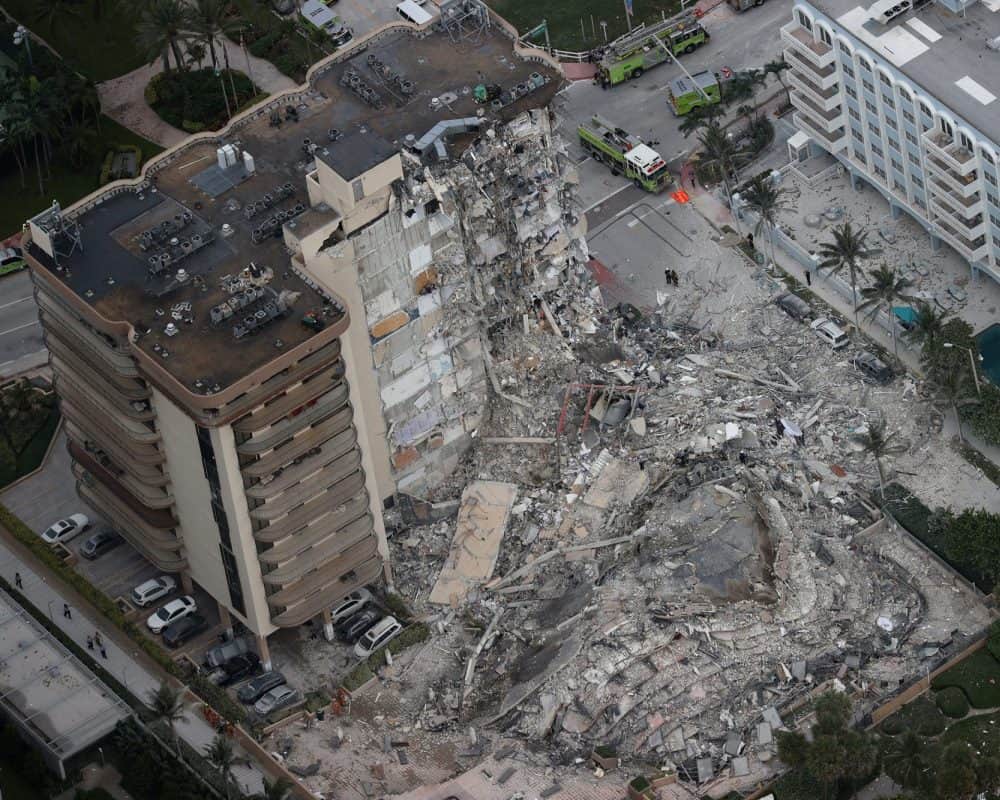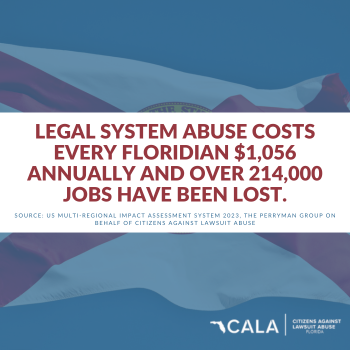


As I write this article, we have recently passed the twenty-year mark of the September 11th attack on our country, and just under four months since South Florida’s most catastrophic disaster, where 98 innocent souls perished in the early morning hours of June 24th, 2021.
Most of us have witnessed video footage showing the violent nature by which the Champlain Towers South building, a luxury twelve-story condo structure constructed in 1980, dropped to the ground without any apparent catalyst. As we revisited footage of New York’s twin-tower collapse, it was difficult to overlook similarities in the progressive and violent manner by which these buildings collapsed as well as the horror and disbelief it inspired. But for now, that is where the comparisons must end, since there has not been even a mention of a possible explosion, and speculation has focused on the building’s structure. The truth is, nobody seems to have the slightest clue as to what caused the Champlain Tower South tower to experience such a significant and unusual structural failure.
One would expect that a catastrophe of this magnitude, which involves a massive loss of life, unfathomable trauma, a fortune in property losses, claims of negligence and corruption, drawing question to both the professional capacity of governmental agencies as well as the integrity of our country’s building codes, would be front and center on the national agenda. However, with COVID still playing havoc on people’s lives, our federal government in disarray, chaos in Afghanistan, our borders being overrun, inflation woes, disastrous wildfires, hurricanes, tornados, floods, earthquakes, and a domestic crime wave on steroids. It’s no wonder that news on the Surfside collapse is virtually non-existent. Instead, we are forced to stomach infrequent commentaries reminding South Floridians just how little progress has been made. Comments by the National Institute of Standards and Technology (NIST), who is leading the investigation, suggests that it may take years to ascertain a cause for the collapse. However, NIST also has some skin in the game, since this federal agency is responsible for examining, testing, and providing direction for much of the methodology trusted by architects and engineers. While this institution may be the most qualified to lead in the investigation, I cannot help but wonder if this process will deliver true transparency.
To be fair, there have been some areas of impressive progress, just not in areas one would have expected. It has been confirmed that billionaire Hussain Sajwani, of the Dubai-based DAMAC Properties, has submitted a bid to purchase the 1.9-acre Surfside Beach parcel of land, located on Collins Avenue and the Atlantic Ocean, for $120 million dollars. This bid had been rumored to be in the works as early as August of 2021, about a month after the collapse. Recent reports also confirm that as of October 10th, the city of Surfside has fast-tracked hearings to maintain the site’s previous zoning, allowing for a 12-story structure with a maximum of 136 apartments totaling no more than 202,000 sellable square feet. This may sound like progress is being made, but considering that it takes years for government officials to make any decision, and that the Champlain Tower landsite underwent a lengthy search, rescue and recovery effort, forensic on-site investigations, additional demolition of the remaining structure, the delicate removal of personal items and evidence, the final clearing of the land, while having this sale negotiated and zoning hearings within 120 days has to be a record; but why the rush to sell and why the unbridled eagerness to buy?
Aside from being a very tasteless claim of progress, it is also significant and quite surprising. To date, the only pleasing news is that virtually every major South Florida developer has passed on getting involved with the land at this juncture. One must question the motivation behind a buyer so eager to take a $120 million dollar gamble, a price that is estimated to be more than $20 million above the property’s current appraised value, on a parcel of land that may find itself tied up in litigation and will carry a stigma of tragedy and death that will be impossible to elude. Furthermore, how can “the process” place a priority position on selling the land before determining the cause for the collapse?
There are a multitude of reasons why the land should not be sold until investigations are concluded and only a few unappealing reasons why it should. The Surfside collapse is still inexplicable and the investigations, whose results look to have very serious legal and financial implications, are still far from being completed. Obviously, without knowing what caused the collapse, we cannot begin to determine what was done wrong, what can be done better and how to prevent it from happening again. It also allows a potential buyer to bid on the property without much competition, under chaotic conditions, with zoning concessions provided only due to these extreme circumstances. It will also make it virtually impossible for the property owners to insist that an appropriate memorial be placed on the site, since the buyer is going to do everything in their power to have this moment in the property’s past, not play a role in the property’s future. Therefore, the sale of the land now accomplishes nothing for the victims other than helping them cash out under very undesirable circumstances, while giving up any possibility of having the property converted into a park with an appropriate memorial.
If the issue is coming up with necessary funds to address the victim’s immediate financial needs, which is obviously among the most important tasks at hand, this should be possible without being forced into a distress sale. Aside from insurance payouts, which are insignificant given the scope of things, these folks own a parcel of land that is worth about $100 million dollars. So, why sell the land when those funds could just as easily be borrowed against the land’s equity while these investigations are underway? There are also discussions regarding mortgage forgiveness by lenders on the victim’s home loans. There are no homes left to pay for and there may be several very profound reasons why. If there ever existed a situation where mortgage forgiveness should apply, it is with the victims of the Surfside collapse. If this tragedy could have been prevented, these discussions would take on a much different tone. I see no reason why these victims can’t get paid on the land, on their units, their possession, and a lot more, while maintaining their leverage in mandating their desire for a memorial on the site, which is what most of us locals would deem appropriate.
The Champlain Tower tragedy is considered the third deadliest structural failure in United States history, rivaled in severity only by the Knickerbocker Theater collapse of 1922 in Washington D.C., where 98 patrons were killed and 133 injured. The cause of the Knickerbocker collapse was obvious, as a two-day-long blizzard piled so much snow on the structure’s roof that it collapsed. The second most catastrophic structural failure was in July of 1981, when the overhead walkway of the Hyatt Regency Hotel in Kansas City, Missouri crashed to the ground killing 114 and injuring 216 more. This collapse shares many similarities to our own overhead walkway collapse of 2018 when the Florida International University (FIU) overhead walkway collapsed. killing 6 people and injuring 10 others. Both of these failures were attributed to similar and significant design flaws. But to learn about the worst structural collapse in US history, you’ll need to dust off your history books and turn back to January 1860, when the Pemberton Mill in Lawrence, Massachusetts, an industrial building, suddenly fell, killing 144 individuals while injuring 166 others.
The collapse in Surfside is not only very rare, but it is also among the most significant structural failures in our country’s history. However, what frightens me more than the collapse is how authorities, whose role is to protect the public against these types of catastrophic events, have chosen to react. On July 14th CNN reported a conversation with Jim McGuinness, the City of Surfside head building inspector and the individual who inspected work being performed on the Champlain Tower South building’s roof just one day before the collapse. When questioned about there being a chance that building inspectors may have missed some obvious red flags, he responded “Our job is life safety in buildings. Period. That’s our job,” McGuinness told CNN, though he added that building owners have a responsibility to maintain their properties. “We’re the guys who help people help themselves.” But, if that were the case, someone should have helped these victims identify potentially catastrophic structural issues they were obviously not qualified to identify on their own. Fortunately, after CNN’s interview, Surfside inspectors were instructed to report any structural issues at all inspection sites. The thought that this is a new brainstorm directive, and that inspectors have not been doing this from day one, is confusing and quite terrifying.
Signs of complacency and a total disregard for public safety by public officials does not end there. In late August, about a month after the Surfside collapse, a story broke about a building in Miami Beach, the Lois Apartments, located at 2001 Bay Drive in the waterfront community of Isle of Normandy. The Lois Apartment happens to be owned by Mr. Charles Burkett, the mayor of the City of Surfside and real estate investor. The Lois Apartment was cited for several severe structural and safety issues, which had initially occurred during Hurricane Irma in 2017 and never repaired. When Mr. Burkett was asked to explain why, after four years, these damages had never been addressed, the mayor responded that the delays were due to permitting issues and lost plans. The mayor of Surfside did not address these issues for four-years because he claims that the necessary permits could not be obtained. However, after this scandal broke, Mr. Burkett was able to obtain the necessary permits to initiate the repairs in just three days. But this is no victory for the tenants, who have had to live in substandard and dangerous conditions for years and have now been issued a notice to vacate within 45 days.
Nobody is going to step up and even imply that mistakes are being made, that mistakes were made, that rules were broken, or that they should have done more to circumvent the tragic issues we are all facing today. In my previous piece, I discussed the probable ripple effects of the Surfside collapse, where city and county inspectors would be playing catchup, inspecting as many buildings as possible for structural issues and code violations. Justifiable or not, we are now witnessing buildings getting slammed with violations, while individuals and families are being evacuated and displaced. While much of these efforts look to target older construction, I am alarmed to see the number of newer structures, built less than 15 years ago, now being forced to undergo highly invasive and extremely expensive structural repairs. While we all agree that it is imperative that our city, county, and state agencies utilize all their resources to inspect and verify the condition of all structures, what is occurring today seems to be uniquely related to the Surfside collapse.
The Surfside collapse has caused inspectors to identify problems that had been previously overlooked and now classify them appropriately as severe structural and safety issues. These assessments are hard to dispute, but we must understand that the extent of the damage now being found does not happen overnight. Steel columns don’t get rusted through to the core, concrete blocks do not crumble, and severe water damage does not just dry up and go away. It takes years of problems being neglected, improperly repaired, and swept under the rug for a potentially dangerous situation to evolve into a catastrophic one. Regardless, many condo owners may now find themselves having to choose between paying an enormous assessment or be forced to sell their home. To make matters worse, even if an owner decides to sell, they may still be on the hook for paying the assessment, since buyers are unlikely to flip the bill when purchasing a unit in what will now be classified by the market as a troubled tower. Buyers will justifiably treat their purchase like they would any distress sale, virtually guaranteeing the owner loses much, if not all their equity, while wiping out a valuable part of their net worth. The most distressing part is that these owners and tenants had little or nothing to do with the decision to allow these problems to fester and be permitted to evolve into something far more dangerous; the owners, tenants, and Surfside victims’ only mistake is trusting that our system works.
This is all occurring during South Florida’s most significant real estate boom, which has inventory at extremely low levels and prices continuing to climb. So, where do these unsuspecting, now displaced owners and tenants go? This knee-jerk policy of tackling violations with an iron first is understandable, but why are victims being made to suffer more than they already have? Let’s be clear- many condo owners will not be able to pay the cost of assessments and rental tenants will have no feasible options when looking to replace their homes. So, aside from the innocent victims of the Surfside collapse, are we now adding to the list of those impacted to include virtually anyone who has ever decided to buy a condo? We constantly hear officials state that all possible measures are being taken to ensure that these tragedies never happen again, but the real question should be, who is stepping up and taking responsibility for what is happening now?
Ricardo Wolf with Wolf Realty has been developing and brokering South Florida residential and commercial real estate since 1970. He has developed dozens of commercial and residential projects and has sold well over a billion in luxury residential homes and condos. Today he is focusing on representing buys and sellers on luxury properties as well as placing clients on coastal Florida markets that have historically been overlooked.

You May Also Like
Top Stories
Share this story:On Thursday, Florida Republicans U.S. Sens. Marco Rubio and Rick Scott welcomed the Senate’s unanimous passage of their resolution commemorating one year...
Environment
Share this story:This week, the U.S. Senate Climate Solutions threw its support behind U.S. Sen. Marco Rubio’s, R-Fla., “Restoring Resilient Reefs Act” and “Built...
Business
Share this story:With lawmakers in Tallahassee debating legislation calling for stronger structural and building safety inspections makes its way through the legislative process, Florida...
Florida News
On the U.S. House Science, Space and Technology Committee, U.S. Rep. Charlie Crist, D-Fla., was able to amend the “National Institute of Standards and...









james
October 23, 2021, 11:01 am at 11:01 am
written by an idiot.
Anonymous
October 23, 2021, 3:12 pm at 3:12 pm
agree.